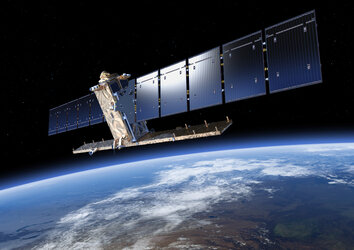Sentinel-1B journeys back to Earth
The Sentinel-1B satellite, the second satellite of the Copernicus Sentinel-1 mission, completed its disposal process – which included lowering its orbit and passivating its systems to ensure re-entry into Earth’s atmosphere within 25 years.
This careful operation highlights the European Union’s and ESA’s commitment to space safety and sustainability and provides valuable experience for the disposal of current and future spacecraft.
Launched on 25 April 2016, the Sentinel-1B spacecraft joined Sentinel-1A to complete the Sentinel-1 constellation. For over five years, these two satellites collected the largest global, open dataset of radar data in the world. The mission was the first to launch for Copernicus, the Earth observation component of the European Union’s space programme.
The ambitious Sentinel-1 mission raised the bar for spaceborne radar, providing continuous radar imaging for numerous Copernicus services and applications. This includes ice mapping, iceberg tracking, glacier-velocity monitoring as well as monitoring ground deformation resulting from subsidence, earthquakes and volcanoes, water and soil management, as well as supporting humanitarian aid and disaster response efforts.
On 23 December 2021, Sentinel-1B suffered a failure in the platform unit that powered the Synthetic Aperture Radar, causing the payload to become inoperative. After multiple attempts to recover the spacecraft, the mission was declared ended on 3 August 2022. Since then, the Sentinel-1 mission has solely relied on the Sentinel-1A satellite.

Meticulous planning
Preparations for Sentinel-1B’s disposal began in September 2022, right after the mission ended.
Building on their shared commitment to reducing space debris, a collaborative effort between experts from ESA, the European Commission, as well as industrial partners, led to a well-structured disposal plan that maximised the satellite's remaining potential.
The plan, based on ESA’s previous satellite disposal experiences, involved multiple stages that allowed the ESA team to monitor and adjust as needed, after which the reentry itself will be uncontrolled:
- Orbit clear-up: Sentinel-1B’s orbit was lowered by a few kilometres to free up the orbit for the arrival of Sentinel-1C and Sentinel-1D satellites.
- Manoeuvre testing: New manoeuvres were tested and validated to complement conventional ones, and lower altitude much further.
- Active orbit lowering: The spacecraft was placed it in a final orbit, from which it will naturally decay and eventually burn up in the atmosphere.
- Passivation: The spacecraft was passivated, to remove as much stored energy as possible to avoid accidental breakups, and all powered systems were actively shutdown.
Disposal operations for Sentinel-1B began in February 2023, as planned. For the first six months, the operations went smoothly but as the orbit lowering progressed the teams had to overcome multiple challenges to stay on track.
In April 2024, the final orbital altitude was reached, allowing for re-entry within 25 years. Electrical passivation took place on 12 September 2024, marking the end of the satellite’s operational life.
This careful operation helped gather useful knowledge about the spacecraft's capabilities and limitations, which will facilitate future Sentinel-1 operations for years to come.

Last signal received
The final signal from the spacecraft was received on 12 September, just before the onboard transmitter, which communicates with ground control, was completely switched off.
The passivation process involved minimising the stored energy on the spacecraft – which included discharging its battery – and actively shutting down all powered systems where possible. The spacecraft was also configured so that none of the deactivated systems could be automatically reactivated.
Following passivation, the spacecraft became what is known as a ‘ballistic’ object, meaning it is no longer controlled by itself or ground teams.
Due to its size and expected orientation, the spacecraft can be accurately tracked by the US and EU Space Object Tracking Networks, allowing for precise predictions of its orbital decay and trajectory. Spacecraft operators (including ESA’s own Space Debris Office) keep track of such objects so as to safely perform avoidance manoeuvres with their satellites.
The spacecraft is expected to reenter Earth's atmosphere in 24 years, though this estimate carries some uncertainty due to factors like solar activity, which affects atmospheric drag.
Invaluable data
Sentinel-1B has generated a unique data collection that is being used daily by thousands of users across the world. The data remains available online on the Copernicus Data Space Ecosystem and will continue contributing to a better understanding of Earth.
The Sentinel-1C satellite, scheduled for launch at the end of 2024 on a Vega-C rocket, will replace the Sentinel-1B satellite, ensuring continuity of data for Sentinel services and applications.
Together with Sentinel-1D, it will extend the mission's capabilities and provide a long-term outlook for the next decade, until the next generation of Sentinel-1 satellites takes over.















 Germany
Germany
 Austria
Austria
 Belgium
Belgium
 Denmark
Denmark
 Spain
Spain
 Estonia
Estonia
 Finland
Finland
 France
France
 Greece
Greece
 Hungary
Hungary
 Ireland
Ireland
 Italy
Italy
 Luxembourg
Luxembourg
 Norway
Norway
 The Netherlands
The Netherlands
 Poland
Poland
 Portugal
Portugal
 Czechia
Czechia
 Romania
Romania
 United Kingdom
United Kingdom
 Slovenia
Slovenia
 Sweden
Sweden
 Switzerland
Switzerland


































